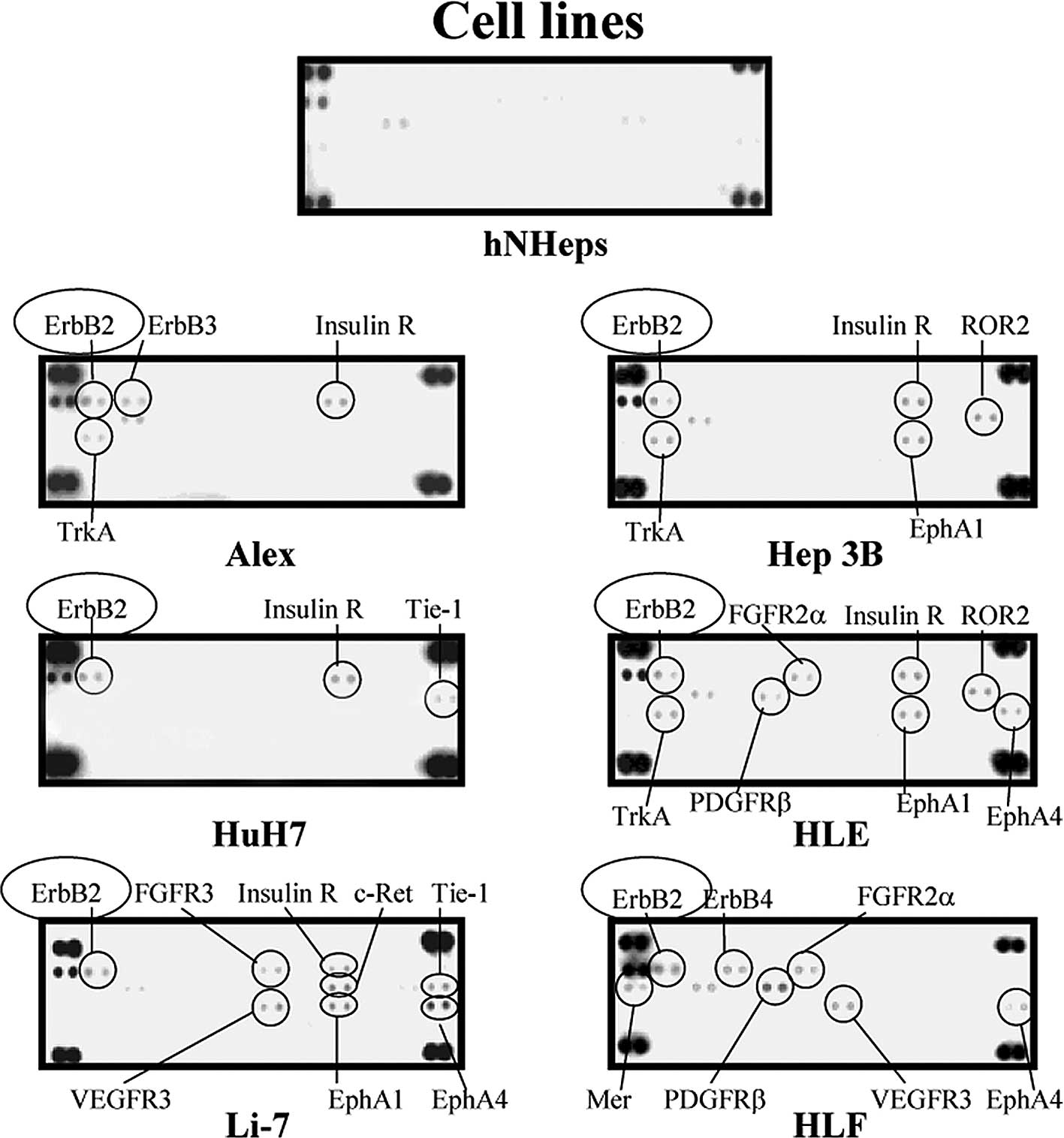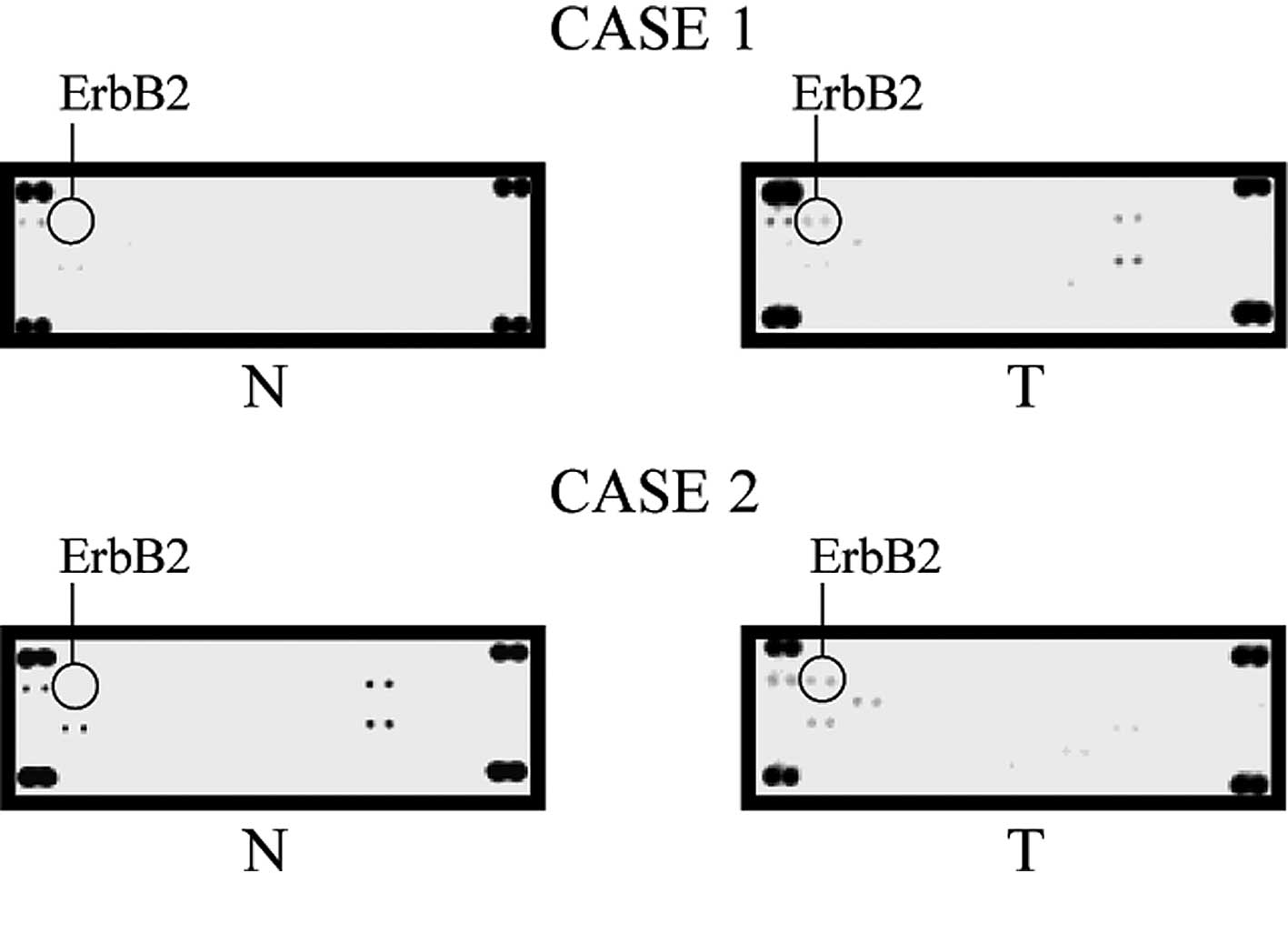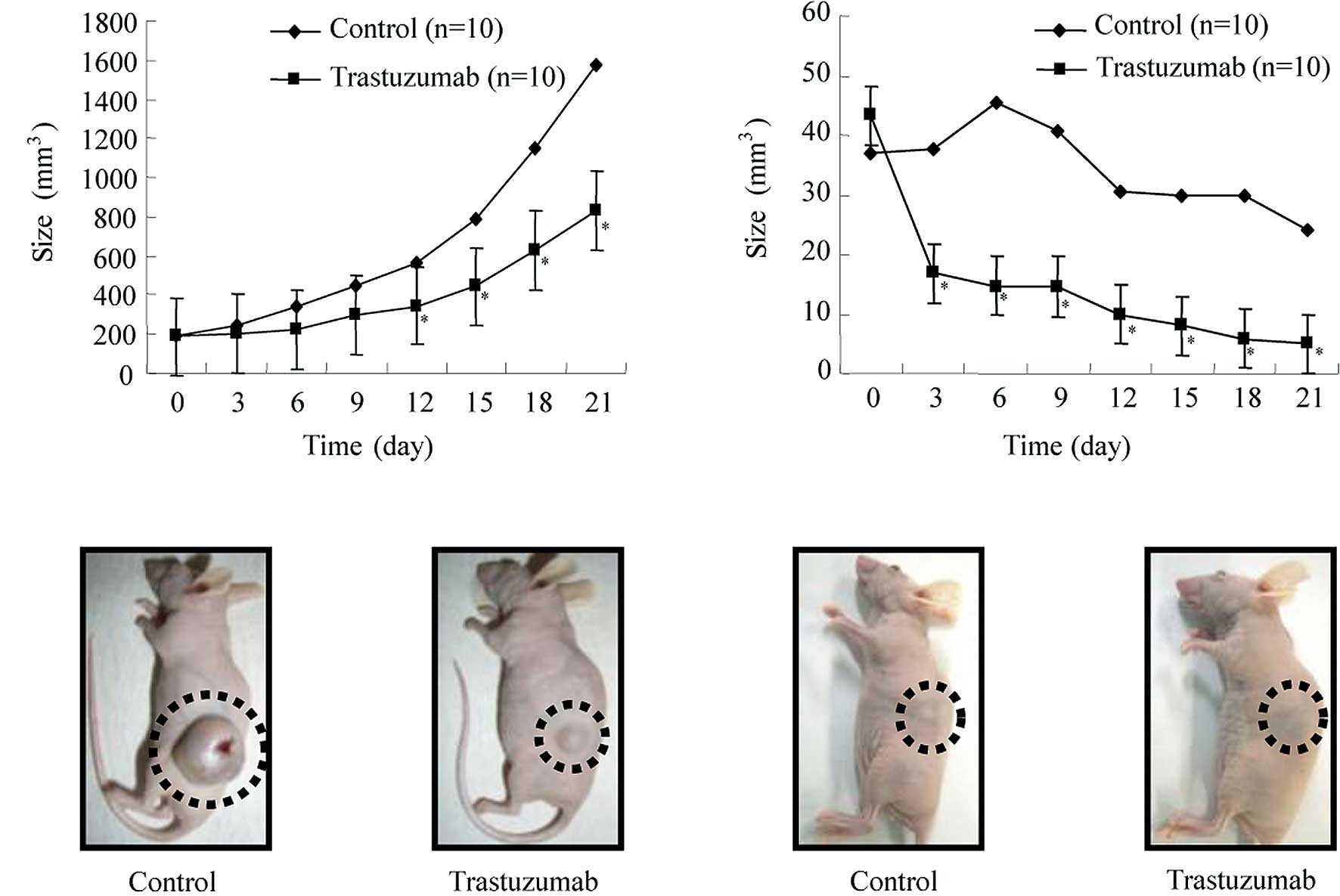|
1.
|
Parkin DM, Bray F, Ferlay J and Pisani P:
Global cancer statistics, 2002. CA Cancer J Clin. 55:74–108. 2005.
View Article : Google Scholar
|
|
2.
|
Poon D, Anderson BO, Chen LT, et al:
Management of hepatocellular carcinoma in Asia: consensus statement
from the Asian Oncology Summit 2009. Lancet Oncol. 10:1111–1118.
2009. View Article : Google Scholar : PubMed/NCBI
|
|
3.
|
Robinson DR, Wu YM and Lin SF: The protein
tyrosine kinase family of the human genome. Oncogene. 19:5548–5557.
2000. View Article : Google Scholar : PubMed/NCBI
|
|
4.
|
Parkin DM: Global cancer statistics in the
year 2000. Lancet Oncol. 2:533–543. 2001.PubMed/NCBI
|
|
5.
|
Becker JC, Muller-Tidow C, Serve H,
Domschke W and Pohle T: Role of receptor tyrosine kinases in
gastric cancer: new targets for a selective therapy. World J
Gastroenterol. 12:3297–3305. 2006.PubMed/NCBI
|
|
6.
|
Hubbard SR and Till JH: Protein tyrosine
kinase structure and function. Annu Rev Biochem. 69:373–398. 2000.
View Article : Google Scholar : PubMed/NCBI
|
|
7.
|
Tanner M, Hollmen M, Junttila TT, et al:
Amplification of HER-2 in gastric carcinoma: association with
Topoisomerase IIalpha gene amplification, intestinal type, poor
prognosis and sensitivity to trastuzumab. Ann Oncol. 16:273–278.
2005. View Article : Google Scholar : PubMed/NCBI
|
|
8.
|
Svensson S, Jirström K, Rydén L, Roos G,
Emdin S, Ostrowski MC and Landberg G: ERK phosphorylation is linked
to VEGFR2 expression and Ets-2 phosphorylation in breast cancer and
is associated with tamoxifen treatment resistance and small tumours
with good prognosis. Oncogene. 24:4370–4379. 2005. View Article : Google Scholar : PubMed/NCBI
|
|
9.
|
Gong J, Morishita A, Kurokohchi K, et al:
Use of protein array to investigate receptor tyrosine kinases
activated in gastric cancer. Int J Oncol. 36:101–106.
2010.PubMed/NCBI
|
|
10.
|
Cao C, Albert JM, Geng L, Ivy PS, Sandler
A, Johnson DH and Lu B: Vascular endothelial growth factor tyrosine
kinase inhibitor AZD2171 and fractionated radiotherapy in mouse
models of lung cancer. Cancer Res. 66:11409–11415. 2006. View Article : Google Scholar : PubMed/NCBI
|
|
11.
|
Morishita A, Gong J, Nomura T, et al: The
use of protein array to identify targetable receptor tyrosine
kinases for treatment of human colon cancer. Int J Oncol.
37:829–835. 2010. View Article : Google Scholar : PubMed/NCBI
|
|
12.
|
Zhang G, Zhang Q, Zhang Q, et al:
Expression of nucleostemin, epidermal growth factor and epidermal
growth factor receptor in human esophageal squamous cell carcinoma
tissues. J Cancer Res Clin Oncol. 136:587–594. 2010. View Article : Google Scholar : PubMed/NCBI
|
|
13.
|
Masaki T, Tokuda M, Yoshida S, et al:
Comparison study of the expression of myristoylated alanine-rich C
kinase substrate in hepatocellular carcinoma, liver cirrhosis,
chronic hepatitis, and normal liver. Int J Oncol. 26:661–671.
2005.
|
|
14.
|
Yoshida S, Masaki T, Feng H, et al:
Enhanced expression of adaptor molecule p46 Shc in nuclei of
hepatocellular carcinoma cells: study of LEC rats. Int J Oncol.
25:1089–1096. 2004.PubMed/NCBI
|
|
15.
|
Bennasroune A, Gardin A, Aunis D, Crémel G
and Hubert P: Tyrosine kinase receptors as attractive targets of
cancer therapy. Crit Rev Oncol Hematol. 50:23–38. 2004. View Article : Google Scholar : PubMed/NCBI
|
|
16.
|
Llovet JM, Ricci S, Mazzaferro V, et al:
Sorafenib in advanced hepatocellular carcinoma. N Engl J Med.
359:378–390. 2008. View Article : Google Scholar : PubMed/NCBI
|
|
17.
|
Desmet VJ, Gerber M, Hoofnagle JH, Manns M
and Scheuer PJ: Classification of chronic hepatitis: diagnosis,
grading and staging. Hepatology. 19:1513–1520. 1994. View Article : Google Scholar : PubMed/NCBI
|
|
18.
|
Yukimasa S, Masaki T, Yoshida S, et al:
Enhanced expression of p46 Shc in the nucleus and p52 Shc in the
cytoplasm of human gastric cancer. Int J Oncol. 26:905–911.
2005.PubMed/NCBI
|
|
19.
|
Mohammad HS, Kurokohchi K, Yoneyama H, et
al: Annexin A2 expression and phosphorylation are up-regulated in
hepatocellular carcinoma. Int J Oncol. 33:1157–1163.
2008.PubMed/NCBI
|
|
20.
|
Nonomura T, Masaki T, Morishita A, et al:
Identification of c-Yes expression in the nuclei of hepatocellular
carcinoma cells: involvement in the early stages of
hepatocarcinogenesis. Int J Oncol. 30:105–111. 2007.PubMed/NCBI
|
|
21.
|
D'Incalci M, Colombo T, Ubezio P, et al:
The combination of yondelis and cisplatin is synergistic against
human tumor xenografts. Eur J Cancer. 39:1920–1926. 2003.PubMed/NCBI
|
|
22.
|
Bazley LA and Gullick WJ: The epidermal
growth factor receptor family. Endocr Relat Cancer. 12:17–27. 2005.
View Article : Google Scholar
|
|
23.
|
Schlessinger J: Ligand-induced,
receptor-mediated dimerization and activation of EGF receptor.
Cell. 110:669–672. 2002. View Article : Google Scholar : PubMed/NCBI
|
|
24.
|
Hermanova M, Lukas Z, Nenutil R, et al:
Amplification and overexpression of HER-2/neu in invasive ductal
carcinomas of the pancreas and pancreatic intraepithelial neoplasms
and the relationship to the expression of p21 (WAF1/CIP1).
Neoplasma. 51:77–83. 2004.PubMed/NCBI
|
|
25.
|
Friess T, Scheuer W and Hasmann M:
Erlotinib antitumor activity in non-small cell lung cancer models
is independent of HER1 and HER2 overexpression. Anticancer Res.
26:3505–3512. 2006.PubMed/NCBI
|
|
26.
|
Hatake K, Tokudome N and Ito Y:
Tanstuzumab treatment for breast cancer. Intern Med. 46:149–150.
2007. View Article : Google Scholar
|
|
27.
|
Larbouret C, Robert B, Navarro-Teulon I,
et al: In vivo therapeutic synergism of anti-epidermal growth
factor receptor and anti-HER2 monoclonal antibodies against
pancreatic carcinomas. Clin Cancer Res. 13:3356–3362. 2007.
View Article : Google Scholar
|
|
28.
|
Lara PN Jr, Chee KG, Longmate J, et al:
Trastuzumab plus docetaxel in HER-2/neu-positive prostate
carcinoma: final results from the California Cancer Consortium
Screening and Phase II Trial. Cancer. 100:2125–2131. 2004.
View Article : Google Scholar
|
|
29.
|
Shun CT, Wu MS, Lin JT, et al:
Relationship of p53 and c-erbB-2 expression to histopathological
features, Helicobacter pylori infection and prognosis in
gastric cancer. Hepatogastroenterology. 44:604–609. 1997.PubMed/NCBI
|
|
30.
|
Berchuck A, Kamel A, Whitaker R, et al:
Overexpression of her2/neu is associated with poor survival in
advanced epithelial ovarian cancer. Cancer Res. 50:4087–4091.
1990.PubMed/NCBI
|
|
31.
|
Grushko TA, Filiaci VL, Mundt AJ,
Ridderstråle K, Olopade OI and Fleming GF; Gynecologic Oncology
Group: An exploratory analysis of HER-2 amplification and
overexpression in advanced endometrial carcinoma: a Gynecologic
Oncology Group study. Gynecol Oncol. 108:3–9. 2008. View Article : Google Scholar : PubMed/NCBI
|
|
32.
|
Saffari B, Jones LA, el-Naggar A, Felix
JC, George J and Press MF: Amplification and overexpression of
HER-2/neu (c-erbB2) in endometrial cancers: correlation with
overall survival. Cancer Res. 55:5693–5698. 1995.PubMed/NCBI
|
|
33.
|
Ross JS, Sheehan C, Hayner-Buchan AM, et
al: HER-2/neu gene amplification status in prostate cancer by
fluorescence in situ hybridization. Hum Pathol. 28:827–833. 1997.
View Article : Google Scholar : PubMed/NCBI
|
|
34.
|
Sato K, Moriyama M, Mori S, et al: An
immunohistologic evaluation of C-erbB-2 gene product in patients
with urinary bladder carcinoma. Cancer. 70:2493–2498. 1992.
View Article : Google Scholar : PubMed/NCBI
|
|
35.
|
Slomovitz BM, Broaddus RR, Burke TW, et
al: Her-2/neu overexpression and amplification in uterine papillary
serous carcinoma. J Clin Oncol. 22:3126–3132. 2004. View Article : Google Scholar : PubMed/NCBI
|
|
36.
|
Villella JA, Cohen S, Smith DH, Hibshoosh
H and Hershman D: HER-2/neu overexpression in uterine papillary
serous cancers and its possible therapeutic implications. Int J
Gynecol Cancer. 16:1897–1902. 2006. View Article : Google Scholar : PubMed/NCBI
|
|
37.
|
Bekaii-Saab T, Williams N, Plass C, Calero
MV and Eng C: A novel mutation in the tyrosine kinase domain of
ERBB2 in hepatocellular carcinoma. BMC Cancer. 6:2782006.
View Article : Google Scholar : PubMed/NCBI
|
|
38.
|
Fuchs BC, Fujii T, Dorfman JD, et al:
Epithelial-to-mesenchymal transition and integrin-linked kinase
mediate sensitivity to epidermal growth factor receptor inhibition
in human hepatoma cells. Cancer Res. 68:2391–2399. 2008. View Article : Google Scholar
|
|
39.
|
Neo SY, Leow CK, Vega VB, et al:
Identification of discriminators of hepatoma by gene expression
profiling using a minimal dataset approach. Hepatology. 39:944–953.
2004. View Article : Google Scholar : PubMed/NCBI
|
|
40.
|
Rasi G, Serafino A, Bellis L, et al: Nerve
growth factor involvement in liver cirrhosis and hepatocellular
carcinoma. World J Gastroenterol. 13:4986–4995. 2007.PubMed/NCBI
|
|
41.
|
Chen G, Wang Y, Zhou M, Shi H, Yu Z, Zhu Y
and Yu F: EphA1 receptor silencing by small interfering RNA has
antiangiogenic and antitumor efficacy in hepatocellular carcinoma.
Oncol Rep. 23:563–570. 2010.PubMed/NCBI
|
|
42.
|
Dhar DK, Naora H, Yamanoi A, Ono T, Kohno
H, Otani H and Nagasue N: Requisite role of VEGF receptors in
angiogenesis of hepatocellular carcinoma: a comparison with
angiopoietin/Tie pathway. Anticancer Res. 22:379–386.
2002.PubMed/NCBI
|
|
43.
|
Harimoto N, Taguchi K, Shirabe K, et al:
The significance of fibroblast growth factor receptor 2 expression
in differentiation of hepatocellular carcinoma. Oncology.
78:361–368. 2010. View Article : Google Scholar : PubMed/NCBI
|
|
44.
|
Qiu WH, Zhou BS, Chu PG, et al:
Over-expression of fibroblast growth factor receptor 3 in human
hepatocellular carcinoma. World J Gastroenterol. 11:5266–5272.
2005.PubMed/NCBI
|
|
45.
|
Avila MA, Berasain C, Sangro B and Prieto
J: New therapies for hepatocellular carcinoma. Oncogene.
25:3866–3884. 2006. View Article : Google Scholar : PubMed/NCBI
|
|
46.
|
Musholt PB, Imkamp F, von Wasielewski R,
Schmid KW and Musholt TJ: RET rearrangements in archival oxyphilic
thyroid tumors: new insights in tumorigenesis and classification of
Hürthle cell carcinomas? Surgery. 134:881–889. 2003.PubMed/NCBI
|













